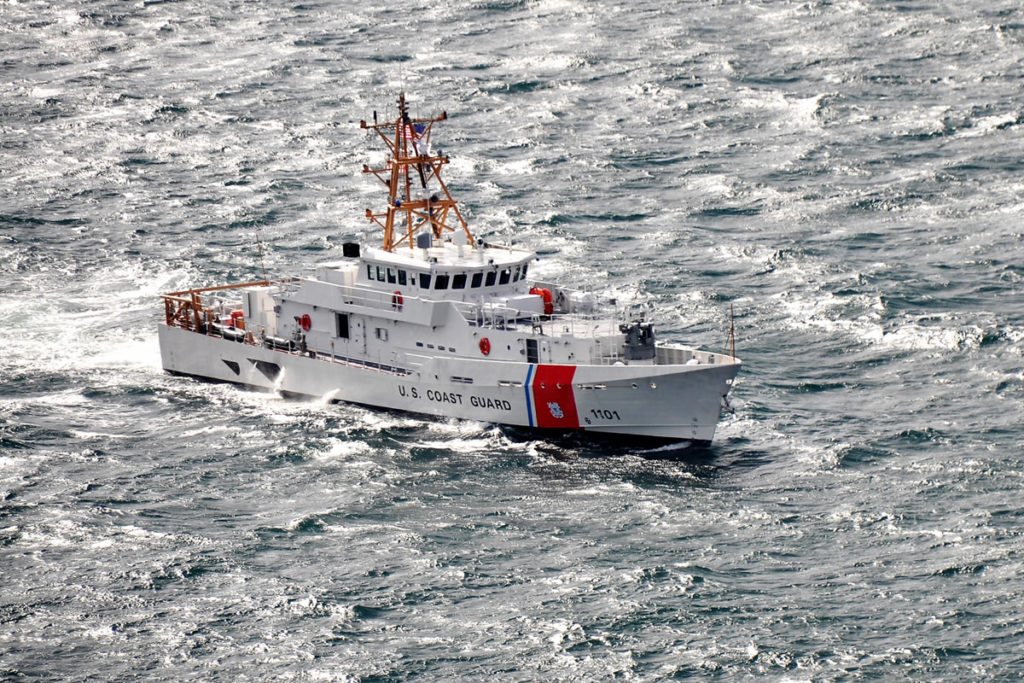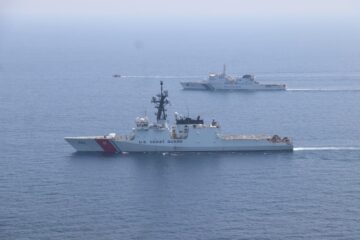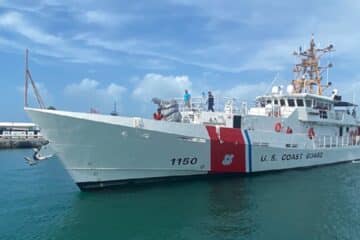USCG press release
Stationing FRCs in Bahrain supports Patrol Forces Southwest Asia (PATFORSWA), the Coast Guard’s largest unit outside of the U.S., and its mission to train, organize, equip, support and deploy combat-ready Coast Guard forces in support of U.S. Central Command and national security objectives.
PATFORSWA works with U.S. Central Command in conducting maritime operations to forward U.S. interests, deter and counter disruptive countries, defeat violent extremism and strengthen partner nations’ maritime capabilities in order to secure the maritime environment in the Central Command area of responsibility.
The cutter’s namesake, Emlen Tunnell, served in the Coast Guard during and after World War II (1943-1946) as a steward’s mate. Tunnell was credited with saving the lives of two shipmates on different occasions. In April 1944, Tunnell was unloading cargo from a cargo ship in Papua New Guinea, when it was hit by a Japanese torpedo. Tunnell suffered burns when he used his bare hands to put out a fire on another shipmate. In 1946, he jumped into freezing water while stationed in Newfoundland to save another shipmate who had fallen from the USS Tampa. Tunnell passed away in 1975 and was posthumously awarded the Silver Star Medal by the Coast Guard in 2011.
Tunnell played college football at the University of Toledo and the University of Iowa. After leaving college in 1948, he hitchhiked from his home in Pennsylvania to New York to try out for the New York Giants. He earned a spot on the team, becoming the first Black player for the Giants. He later played for the Green Bay Packers under head coach Vince Lombardi. He was a member of two NFL championship teams and played in nine Pro Bowls. After his playing career ended, Tunnell held scouting and coaching positions for both the Packers and Giants. Tunnell was inducted into the Pro Football Hall of Fame in 1967, the first Black pro football player to receive the honor.
Adm. Karl Schultz, commandant of the Coast Guard, presided over the ceremony. “What really defined Emlen was his character, that selflessness. It was who he was as a human being,” said Schultz. “When this cutter sailed unexpectedly to avoid tropical storm Elsa, Coast Guardsmen who are going to shape the future chapters of the Emlen Tunnell story stepped to the plate, as Emlen did years ago. Maybe not with as many heroics, but they did what Coasties do. They jumped into the breach.”
The Sentinel-class FRCs feature advanced command, control, communications, computers, intelligence, surveillance and reconnaissance equipment; over-the-horizon cutter boat deployment to reach vessels of interest; and improved habitability and seakeeping. The cutters are designed for multiple missions including search and rescue; national defense; ports, waterways and coastal security; drug and migrant interdiction; and fisheries patrols.
The Coast Guard has ordered 64 FRCs to date. With this commissioning, 45 are in service: 12 in Florida; seven in Puerto Rico; four in California; three each in Guam, Hawaii, Texas and New Jersey; and two each in Alaska, Mississippi, North Carolina and Bahrain. Emlen Tunnell will sail to Bahrain with Glen Harris later this year. Future FRC homeports include Boston; Astoria, Oregon; St. Petersburg, Florida; and Kodiak, Seward and Sitka, Alaska.
-End-
About Sentinel-class FRC

The FRC are built by the Louisiana-based firm Bollinger Shipyards, using a design from the Netherlands-based Damen Group, with the Sentinel design based on the company’s Damen Stan 4708 patrol vessel.
USCG Sentinel-class FRC features
- Enhanced response time with a minimum top speed of 28 knots
- Ability to conduct missions on moderate seas up to transit speed for eight hours in all directions
- Ability to survive on very rough seas up to loiter speed for eight hours in all directions
- Armed with a stabilized 25-mm machine gun mount and four crew-served .50-caliber machine guns
- Fully interoperable command and control systems with Coast Guard existing and future assets and with the departments of Homeland Security and Defense
USCG Sentinel-class FRC characteristics
- Length: 154 feet
- Beam: 25 feet
- Draft: 9 feet 6 inches
- Displacement: 353 long tons
- Maximum Speed: 28+ knots
- Range: 2,500 nautical miles
- Endurance: Five days
- Crew: 24






